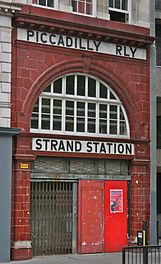| Aldwych | |
|---|---|
 Main entrance to Aldwych station (formerly Strand station) | |
| Location | Aldwych |
| Local authority | City of Westminster |
| Owner | Great Northern, Piccadilly and Brompton Railway |
| Number of platforms |
|
| Key dates | |
| 1907 | Opened |
| 1940 | Closed |
| 1946 | Reopened |
| 1994 | Closed |
| Listed status | |
| Listing grade | II |
| Entry number | 1401034[1] |
| Added to list | 20 July 2011 |
| Other information | |
| Coordinates | 51°30′44″N 0°06′57″W / 51.51215°N 0.11595°W |
Aldwych is a closed station on the London Underground, located in the City of Westminster in Central London. It was opened in 1907 with the name Strand, after the street on which it is located. It was the terminus of the short Piccadilly line branch from Holborn that was a relic of the merger of two railway schemes. The station building is close to the Strand's junction with Surrey Street, near Aldwych. During its lifetime, the branch was the subject of a number of unrealised extension proposals that would have seen the tunnels through the station extended southwards, usually to Waterloo.
Served mostly by a shuttle train and having low passenger numbers, the station and branch were considered for closure several times. Service was offered only during weekday peak hours from 1962 and discontinued in 1994, when the cost of replacing the lifts was considered too high for the income generated.
Disused parts of the station and the running tunnels were used during both world wars to shelter artworks from London's public galleries and museums from bombing. The station is the work of Leslie Green and has long been popular as a filming location, appearing as itself and as other London Underground stations in a number of films. In recognition of its historical significance, the station is a Grade II listed building and is an example of the Modern Style (British Art Nouveau style).[2][3]
London Transport Museum runs guided tours of the station via its "Hidden London" programme throughout the year. The tour takes visitors through the ticket hall, the original lifts, disused platforms and tunnels; and shares findings from the museum's archives on the history of the site.[4]
- ^ Historic England. "Aldwych Underground Station (1401034)". National Heritage List for England. Retrieved 27 July 2011.
- ^ Martin, Andrew (3 February 2013). "London Underground By Design by Mark Ovenden – review". The Guardian. Retrieved 14 April 2021.
- ^ "Green, Leslie". Exploring 20th Century London. Archived from the original on 6 February 2012.
- ^ "Aldwych: The End of the Line". London Transport Museum. Retrieved 10 February 2023.
